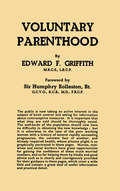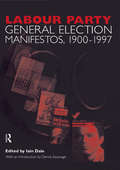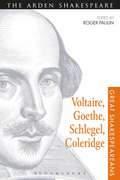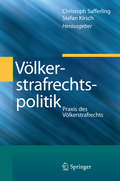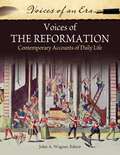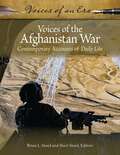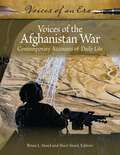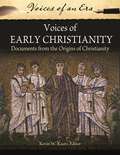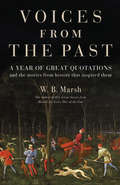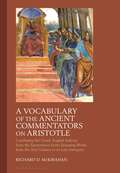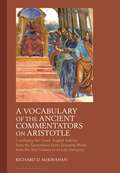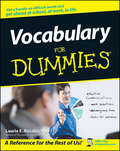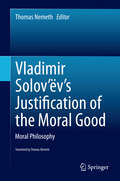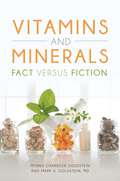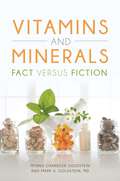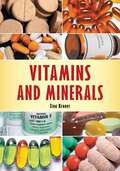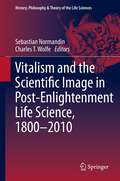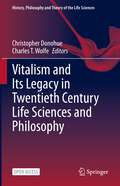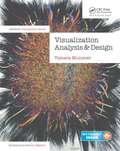- Table View
- List View
Voluntary Parenthood
by Edward F. GriffithVoluntary Parenthood discusses scientific research relating the significance of contraception to ordinary life of the population, specifically to the so-called voluntary parenthood. This seven-chapter text considers the influence of reasonable family planning in marriage.The opening chapter provides an overview of the problems connected with marriage and contraception. The subsequent chapters deal with the different methods of family limitation, the mechanical methods of controlled contraception, and the issues related to abortion. These topics are followed by discussions of the role of sex in marriage and the biological aspects of sex. The closing chapter provides medical case histories concerning various conditions in which pregnancy is contra-indicated.This book is of value to nurses, midwives, social workers, and the general public.
Volume Two. Labour Party General Election Manifestos 1900-1997
by Dennis Kavanagh Iain DaleThis volume brings together for the first time the British Labour Political Party General Election Manifestos, dating back to 1900, and including the most recent General Election manifesto of 1997.The project provides an indispensible source of data about the Labour Party's political ideologies and policy positions, as well as charting their changes over time.The volume has a new introduction written by Dennis Kavanagh, who is Professor of Politics at Liverpool University, and who has already published Political Science and Political Behaviour with Routledge.In addition to the new introduction, the volume includes a comprehensive index, making the volume easy to use.
Volume Two. Labour Party General Election Manifestos 1900-1997
by Dennis Kavanagh Iain DaleThis volume brings together for the first time the British Labour Political Party General Election Manifestos, dating back to 1900, and including the most recent General Election manifesto of 1997.The project provides an indispensible source of data about the Labour Party's political ideologies and policy positions, as well as charting their changes over time.The volume has a new introduction written by Dennis Kavanagh, who is Professor of Politics at Liverpool University, and who has already published Political Science and Political Behaviour with Routledge.In addition to the new introduction, the volume includes a comprehensive index, making the volume easy to use.
Voltaire, Goethe, Schlegel, Coleridge: Great Shakespeareans: Volume III (Great Shakespeareans)
by Roger PaulinGreat Shakespeareans offers a systematic account of those figures who have had the greatest influence on the interpretation, understanding and cultural reception of Shakespeare, both nationally and internationally. In this volume, leading scholars assess the contribution of Voltaire, Goethe, Schlegel and Coleridge to the afterlife and reception of Shakespeare and his plays. Each substantial contribution assesses the double impact of Shakespeare on the figure covered and of the figure on the understanding, interpretation and appreciation of Shakespeare, provide a sketch of their subject's intellectual and professional biography and an account of the wider cultural context, including comparison with other figures or works within the same field.
Voltaire, Goethe, Schlegel, Coleridge: Great Shakespeareans: Volume III (Great Shakespeareans)
by Roger PaulinGreat Shakespeareans offers a systematic account of those figures who have had the greatest influence on the interpretation, understanding and cultural reception of Shakespeare, both nationally and internationally. In this volume, leading scholars assess the contribution of Voltaire, Goethe, Schlegel and Coleridge to the afterlife and reception of Shakespeare and his plays. Each substantial contribution assesses the double impact of Shakespeare on the figure covered and of the figure on the understanding, interpretation and appreciation of Shakespeare, provide a sketch of their subject's intellectual and professional biography and an account of the wider cultural context, including comparison with other figures or works within the same field.
Völkerstrafrechtspolitik: Praxis des Völkerstrafrechts
by Christoph Safferling Stefan KirschZehn Jahre nach dem Inkrafttreten des Völkerstrafgesetzbuches (VStGB) vereinigt der vorliegende Sammelband unterschiedliche Blickwinkel und Perspektiven auf das noch junge Gesetzeswerk und dessen Praxis. Die Bestandsaufnahme enthält – neben einem Blick auf die Rechtslage in Österreich und der Schweiz – Beiträge zur Entstehung des Gesetzes, seiner Anwendung in der Praxis und zu aktuellen Entwicklungen. Dabei wird eines klar: ohne einen interdisziplinären Ansatz, der neben rechtsdogmatischen Erwägungen auch politische und historische Argumente zulässt, können die mit der Ausbildung einer internationalen Strafrechtsordnung verbundenen Herausforderungen nicht gemeistert werden.
Voices of the Reformation: Contemporary Accounts of Daily Life (Voices of an Era)
by John A. WagnerThis fascinating collection of primary source documents furnishes the accounts—in their own words—of those who initiated, advanced, or lived through the Reformation.Starting in 1500, Europe transformed from a united Christendom into a continent bitterly divided between Catholicism and Protestantism by the end of the century. This illuminating text reveals what happened during that period by presenting the social, religious, economic, political, and cultural life of the European Reformation of the 16th century in the words of those who lived through it. Detailed and comprehensive, the work includes 60 primary source documents that shed light on the character, personalities, and events of that time and provides context, questions, and activities for successfully incorporating these documents into academic research and reading projects. A special section provides guidelines for better evaluating and understanding primary documents. Topics include late medieval religion, Martin Luther, reformation in Germany and the Peasants' War, the rise of Calvinism, and the English Reformation.
Voices of the Reformation: Contemporary Accounts of Daily Life (Voices of an Era)
by John A. WagnerThis fascinating collection of primary source documents furnishes the accounts—in their own words—of those who initiated, advanced, or lived through the Reformation.Starting in 1500, Europe transformed from a united Christendom into a continent bitterly divided between Catholicism and Protestantism by the end of the century. This illuminating text reveals what happened during that period by presenting the social, religious, economic, political, and cultural life of the European Reformation of the 16th century in the words of those who lived through it. Detailed and comprehensive, the work includes 60 primary source documents that shed light on the character, personalities, and events of that time and provides context, questions, and activities for successfully incorporating these documents into academic research and reading projects. A special section provides guidelines for better evaluating and understanding primary documents. Topics include late medieval religion, Martin Luther, reformation in Germany and the Peasants' War, the rise of Calvinism, and the English Reformation.
Voices of the Afghanistan War: Contemporary Accounts of Daily Life (Voices of an Era)
by Brian L. Steed Sheri SteedThe War in Afghanistan was the longest military conflict in American history. In a diverse collection of primary documents, this book explores the evolving legacy of the war and its impact on the countless lives it changed forever. Following the terrorist attacks on September 11, 2001, the United States spent almost 20 years at war in Afghanistan until it officially withdrew its military forces in August 2021. As the longest war in American history, the War in Afghanistan cost trillions of dollars to sustain and claimed the lives of thousands of American soldiers and many more Afghan civilians. This book tells the story of the war from its varied perspectives, including documents from American and Afghan politicians, high-ranking military officers, and diplomats. The topics covered are even more diverse, ranging from the building and training of security forces and the use drones in modern warfare to the importance of education and the role of women in combat. What the editors lead readers to understand is that the peoples referred to as Afghans have little in common beyond the land itself-a simple, basic, and ultimately ignored reality at the heart of the U.S. invasion, occupation, and frustration in Afghanistan.
Voices of the Afghanistan War: Contemporary Accounts of Daily Life (Voices of an Era)
The War in Afghanistan was the longest military conflict in American history. In a diverse collection of primary documents, this book explores the evolving legacy of the war and its impact on the countless lives it changed forever. Following the terrorist attacks on September 11, 2001, the United States spent almost 20 years at war in Afghanistan until it officially withdrew its military forces in August 2021. As the longest war in American history, the War in Afghanistan cost trillions of dollars to sustain and claimed the lives of thousands of American soldiers and many more Afghan civilians. This book tells the story of the war from its varied perspectives, including documents from American and Afghan politicians, high-ranking military officers, and diplomats. The topics covered are even more diverse, ranging from the building and training of security forces and the use drones in modern warfare to the importance of education and the role of women in combat. What the editors lead readers to understand is that the peoples referred to as Afghans have little in common beyond the land itself-a simple, basic, and ultimately ignored reality at the heart of the U.S. invasion, occupation, and frustration in Afghanistan.
Voices of Early Christianity: Documents from the Origins of Christianity (Voices of an Era)
by Kevin W. KaatzThis fascinating resource examines the day-to-day lives of early Christians—as depicted through documented accounts of the period—from the beginning of Christianity through 325 CE.Early Christianity drew its doctrine from a variety of sources—personal interpretation, Hebrew scriptures, and church council—yet the core ideology endured, even as the religion transitioned from being the object of persecution to becoming a legal institution in the Roman Empire. This book celebrates the voices that helped create and develop Christianity during that period.Voices of Early Christianity: Documents from the Origins of Christianity is a collection of excerpts from significant documents from early Christian history, organized topically, then listed chronologically within each section. The author compares textual variations among the works of the apostles, as well as key themes over time, and frames the discussion for further critical thinking. Topics include sexuality, marriage, and divorce; food issues; women in early Christianity; and politics and Christianity.
Voices of Early Christianity: Documents from the Origins of Christianity (Voices of an Era)
This fascinating resource examines the day-to-day lives of early Christians—as depicted through documented accounts of the period—from the beginning of Christianity through 325 CE.Early Christianity drew its doctrine from a variety of sources—personal interpretation, Hebrew scriptures, and church council—yet the core ideology endured, even as the religion transitioned from being the object of persecution to becoming a legal institution in the Roman Empire. This book celebrates the voices that helped create and develop Christianity during that period.Voices of Early Christianity: Documents from the Origins of Christianity is a collection of excerpts from significant documents from early Christian history, organized topically, then listed chronologically within each section. The author compares textual variations among the works of the apostles, as well as key themes over time, and frames the discussion for further critical thinking. Topics include sexuality, marriage, and divorce; food issues; women in early Christianity; and politics and Christianity.
Voices From the Past: A year of great quotations – and the stories from history that inspired them
by W.B. MarshIn a treasure trove for history buffs, W.B. Marsh fleshes out the context behind famous quotations associated with each day of the year, sending us back and forth in history from the time of the Ancient Egyptians to the world we live in today. ‘You furnish the pictures, I’ll furnish the war.’ (25 April 1898) Newspaper magnate William Randolph Hearst urges war artist Frederick Remington to stay in Cuba while Hearst publishes lurid tales of an imaginary conflict. ‘I am tasting the stars!’ (4 August 1693) The monk Dom Pérignon tests the result of his new techniques in the making of sparkling wine, and champagne is born. ‘I did not write it. God wrote it. I merely did his dictation.’ (20 March 1852) Harriet Beecher Stowe publishes Uncle Tom’s Cabin, the nineteenth century’s bestseller apart from the Bible. ‘From the sublime to the ridiculous is only a step.’ (18 October 1812) Napoleon’s all-conquering Grande Armée begins its slow and ignominious retreat from Moscow.
A Vocabulary of the Ancient Commentators on Aristotle: Combining the Greek–English Indexes from the Eponymous Series Spanning Works from the 2nd Century CE to Late Antiquity
by Richard D. McKirahanAn astounding project of analysis on more than one hundred translations of ancient philosophical texts, this index of words found in the Ancient Commentators on Aristotle series comprises some 114,000 entries. It forms in effect a unique dictionary of philosophical terms from the post-Hellenistic period through to late antiquity and will be an essential reference tool for any scholar working on the meaning of these ancient texts. As traditional dictionaries have usually neglected to include translation examples from philosophical texts of this period, scholars interested in how meanings of words vary across time and author have been ill served. This index fills a huge gap, therefore, in the lexical analysis of ancient Greek and has application well beyond the reading of ancient philosophical commentaries. Bringing together the full indexes from 110 of the volumes published in Bloomsbury's Ancient Commentators on Aristotle series, McKirahan has combined each word entry and analysed how many times particular translations occur. He presents his findings numerically so that each meaning in turn has a note as to the number of times it is used. For meanings that are found between one and four times the volume details are also given so that readers may quickly and easily look up the texts themselves.
A Vocabulary of the Ancient Commentators on Aristotle: Combining the Greek–English Indexes from the Eponymous Series Spanning Works from the 2nd Century CE to Late Antiquity
by Richard D. McKirahanAn astounding project of analysis on more than one hundred translations of ancient philosophical texts, this index of words found in the Ancient Commentators on Aristotle series comprises some 114,000 entries. It forms in effect a unique dictionary of philosophical terms from the post-Hellenistic period through to late antiquity and will be an essential reference tool for any scholar working on the meaning of these ancient texts. As traditional dictionaries have usually neglected to include translation examples from philosophical texts of this period, scholars interested in how meanings of words vary across time and author have been ill served. This index fills a huge gap, therefore, in the lexical analysis of ancient Greek and has application well beyond the reading of ancient philosophical commentaries. Bringing together the full indexes from 110 of the volumes published in Bloomsbury's Ancient Commentators on Aristotle series, McKirahan has combined each word entry and analysed how many times particular translations occur. He presents his findings numerically so that each meaning in turn has a note as to the number of times it is used. For meanings that are found between one and four times the volume details are also given so that readers may quickly and easily look up the texts themselves.
Vocabulary For Dummies (For Dummies Ser.)
by Laurie E. RozakisSomeone just called you captious. Should you be flattered? Considering your extreme lactose intolerance, is it a good idea to order veau au béchamel from a French menu? Calumny is to slander as obloquy is to a) flattery, b) sermon, or c) invective? You’ve just heard that your new boss is a real martinet, should you be worried or excited about an attractive new addition to your workplace? Your boyfriend says you have no élan, is he telling you you’re all out of yogurt? Starting to wish you’d paid more attention in English class? Don’t worry, it’s never too late to develop a million dollar vocabulary—and Vocabulary For Dummies offers you a fast, fun and easy way to do it. Whether you’re facing standardized tests, or you want to feel more knowledgeable at work or more comfortable in social situations, this book is for you. In no time you’ll: Dramatically expand your vocabulary Speak with style Write with panache Make a better impression a work or school Dine out with confidence Have the right words for formal occasions and ethnic events Get more out of what you read Vocabulary For Dummies doesn’t overwhelm you with endless word lists. Instead, it gives you a complete vocabulary-building program that familiarizes you with words from all areas of life as they’re used in context—from bar mitzvahs to business meetings, PCs to politics—with a host of fun features, including: Word tables organized by common features, such as language of origin, professional or social contexts, similarities, and more Sample conversations incorporate new terms and define related ones Before-and-After examples show how to replace old, general terms with new specific vocabulary Pointers reinforce understanding with examples of correct and incorrect usage Chapters on terms from finance, law, medicine, eating and shopping, history and mythology, various languages, and more Vocabulary For Dummies makes it easier than ever for you to get a handle on difficult words and get ahead at school, at work, and in life.
Vladimir Solov’ëv's Justification of the Moral Good: Moral Philosophy
by Thomas NemethThis new English translation of Solov’ëv’s principal ethical treatise, written in his later years, presents Solov’ëv’s mature views on a host of topics ranging from a critique of individualistic ethical systems to the death penalty, the meaning of war, animal rights, and environmentalism. Written for the educated public rather than for a narrow circle of specialists, Solov’ëv’s work largely avoids technical vocabulary while illustrating his points with references to classical literature from the ancient Greeks to Goethe. Although written from a deeply held Christian viewpoint, Solov’ëv emphasizes the turn from his earlier position, now allegedly developing the independence of moral philosophy from metaphysics and revealed religion. Solov’ëv sees the formal universality of the idea of the moral good in all human beings, albeit that this idea is bereft of material content. This first new English-language translation in a century makes a unique contribution to the study of Solov’ëv’s thought. It uses the text of the second edition published in 1899 as its main text, but provides the variations and additions from the earlier versions of each chapter in running notes. Other unique features of this translation are that the pagination of the widely available 1914 edition is provided in the text, and the sources of Solov’ëv’s numerous Biblical quotations and references as well as literary and historical allusions.
Vitamins and Minerals: Fact versus Fiction
by Myrna Chandler Goldstein Mark A. MDThis accessible reference profiles the vitamins and minerals most important to human health, presenting information in an easy-to-use format and summarizing the findings of key research studies.Everyone knows that vitamins and minerals are nonnegotiable components of optimal health. But what exactly do these substances do in the body, and how much of each is needed? What happens if an individual ingests too little or too much of a particular vitamin or mineral? Which foods are the best sources of them, and are dietary supplements a safe alternative? Do certain vitamins and minerals offer protection against certain diseases and medical conditions?Vitamins and Minerals: Fact versus Fiction provides answers to these and many other questions in an accessible format, backed by summaries of key research findings. This book cuts through the confusion and hype that surround the nutrition and supplements industries to offer readers clear guidance founded on solid medical research. A standardized chapter structure and several appendices make the most important information readily available, while introductory essays explore fundamental topics—such as different types of intake recommendations and how they're determined—in greater depth.
Vitamins and Minerals: Fact versus Fiction
by Myrna Chandler Goldstein Mark A. MDThis accessible reference profiles the vitamins and minerals most important to human health, presenting information in an easy-to-use format and summarizing the findings of key research studies.Everyone knows that vitamins and minerals are nonnegotiable components of optimal health. But what exactly do these substances do in the body, and how much of each is needed? What happens if an individual ingests too little or too much of a particular vitamin or mineral? Which foods are the best sources of them, and are dietary supplements a safe alternative? Do certain vitamins and minerals offer protection against certain diseases and medical conditions?Vitamins and Minerals: Fact versus Fiction provides answers to these and many other questions in an accessible format, backed by summaries of key research findings. This book cuts through the confusion and hype that surround the nutrition and supplements industries to offer readers clear guidance founded on solid medical research. A standardized chapter structure and several appendices make the most important information readily available, while introductory essays explore fundamental topics—such as different types of intake recommendations and how they're determined—in greater depth.
Vitamins and Minerals
by Zina KronerInsightful, objective, and evidence-based, this overview of the most commonly used supplements dispels misinformation and provides facts from a qualified physician's point of view.An endless array of vitamin and mineral supplements are available to health-conscious consumers today, and an increasing number of individuals have incorporated these supplements into their daily routines. Unfortunately, their use is often inspired by rumor rather than sound medical advice. The results of clinical research on these supplements' effectiveness are often inconclusive while some studies have even shown negative health effects from overuse. Instead of relying on media hype and often-conflicting "word-of-mouth" information, people who take nutritional supplements need an authoritative, evidence-based reference text about self-medication with vitamins and minerals. Dr. Zina Kroner has provided exactly that.Vitamins and Minerals is an eye-opening guide that separates truth from myth about dozens of today's common and popular supplements. It covers the effects of the deficiency of each nutrient, its primary uses, dosages, food sources, potential side effects, and mechanism of action, helping readers make informed decisions about use of these under-regulated, over-the-counter "nutraceuticals."
Vitalism and the Scientific Image in Post-Enlightenment Life Science, 1800-2010 (History, Philosophy and Theory of the Life Sciences)
by Sebastian Normandin and Charles T. WolfeVitalism is understood as impacting the history of the life sciences, medicine and philosophy, representing an epistemological challenge to the dominance of mechanism over the last 200 years, and partly revived with organicism in early theoretical biology. The contributions in this volume portray the history of vitalism from the end of the Enlightenment to the modern day, suggesting some reassessment of what it means both historically and conceptually. As such it includes a wide range of material, employing both historical and philosophical methodologies, and it is divided fairly evenly between 19th and 20th century historical treatments and more contemporary analysis. This volume presents a significant contribution to the current literature in the history and philosophy of science and the history of medicine.
Vitalism and Its Legacy in Twentieth Century Life Sciences and Philosophy (History, Philosophy and Theory of the Life Sciences #29)
by Charles T. Wolfe Christopher DonohueThis Open Access book combines philosophical and historical analysis of various forms of alternatives to mechanism and mechanistic explanation, focusing on the 19th century to the present. It addresses vitalism, organicism and responses to materialism and its relevance to current biological science. In doing so, it promotes dialogue and discussion about the historical and philosophical importance of vitalism and other non-mechanistic conceptions of life. It points towards the integration of genomic science into the broader history of biology. It details a broad engagement with a variety of nineteenth, twentieth and twenty-first century vitalisms and conceptions of life. In addition, it discusses important threads in the history of concepts in the United States and Europe, including charting new reception histories in eastern and south-eastern Europe. While vitalism, organicism and similar epistemologies are often the concern of specialists in the history and philosophy of biology and of historians of ideas, the range of the contributions as well as the geographical and temporal scope of the volume allows for it to appeal to the historian of science and the historian of biology generally.
Vital Forces, Teleology and Organization: Philosophy of Nature and the Rise of Biology in Germany (History, Philosophy and Theory of the Life Sciences #21)
by Andrea GambarottoThis book offers a comprehensive account of vitalism and the Romantic philosophy of nature. The author explores the rise of biology as a unified science in Germany by reconstructing the history of the notion of “vital force,” starting from the mid-eighteenth through the early nineteenth century. Further, he argues that Romantic Naturphilosophie played a crucial role in the rise of biology in Germany, especially thanks to its treatment of teleology. In fact, both post-Kantian philosophers and naturalists were guided by teleological principles in defining the object of biological research.The book begins by considering the problem of generation, focusing on the debate over the notion of “formative force.” Readers are invited to engage with the epistemological status of this formative force, i.e. the question of the principle behind organization. The second chapter provides a reconstruction of the physiology of vital forces as it was elaborated in the mid- to late-eighteenth century by the group of physicians and naturalists known as the “Göttingen School.” Readers are shown how these authors developed an understanding of the animal kingdom as a graded series of organisms with increasing functional complexity.Chapter three tracks the development of such framework in Romantic Naturphilosophie. The author introduces the reader to the problem of classification, showing how Romantic philosophers of nature regarded classification as articulated by a unified plan that connects all living forms with one another, relying on the idea of living nature as a universal organism. In the closing chapter, this analysis shows how the three instances of pre-biological discourse on living beings – theory of generation, physiology and natural history – converged to form the consolidated disciplinary matrix of a general biology. The book offers an insightful read for all scholars interested in classical German philosophy, especially those researching the philosophy of nature, as well as the history and philosophy of biology.
Visualizing Research: A Guide to the Research Process in Art and Design (PDF)
by Carole Gray Julian MalinsVisualizing Research guides postgraduate students in art and design through the development and implementation of a research project, using the metaphor of a 'journey of exploration'. For use with a formal programme of study, from masters to doctoral level, the book derives from the creative relationship between research, practice and teaching in art and design. It extends generic research processes into practice-based approaches more relevant to artists and designers, introducing wherever possible visual, interactive and collaborative methods. The Introduction and Chapter 1 'Planning the Journey' define the concept and value of 'practice-based' formal research, tracking the debate around its development and explaining key concepts and terminology. âe~Mapping the Terrainâe(tm) then describes methods of contextualizing research in art and design (the contextual review, using reference material); âe~Locating Your Positionâe(tm) and âe~Crossing the Terrainâe(tm) guide the reader through the stages of identifying an appropriate research question and methodological approach, writing the proposal and managing research information. Methods of evaluation and analysis are explored, and of strategies for reporting and communicating research findings are suggested. Appendices and a glossary are also included. Visualizing Research draws on the experience of researchers in different contexts and includes case studies of real projects. Although written primarily for postgraduate students, research supervisors, managers and academic staff in art and design and related areas, such as architecture and media studies, will find this a valuable research reference. An accompanying website www. visualizingresearch. info includes multimedia and other resources that complement the book.
Visualization Analysis and Design (Ak Peters Visualization Ser.)
by Tamara MunznerLearn How to Design Effective Visualization Systems Visualization Analysis and Design provides a systematic, comprehensive framework for thinking about visualization in terms of principles and design choices. The book features a unified approach encompassing information visualization techniques for abstract data, scientific visualization techniques for spatial data, and visual analytics techniques for interweaving data transformation and analysis with interactive visual exploration. It emphasizes the careful validation of effectiveness and the consideration of function before form. The book breaks down visualization design according to three questions: what data users need to see, why users need to carry out their tasks, and how the visual representations proposed can be constructed and manipulated. It walks readers through the use of space and color to visually encode data in a view, the trade-offs between changing a single view and using multiple linked views, and the ways to reduce the amount of data shown in each view. The book concludes with six case studies analyzed in detail with the full framework. The book is suitable for a broad set of readers, from beginners to more experienced visualization designers. It does not assume any previous experience in programming, mathematics, human-computer interaction, or graphic design and can be used in an introductory visualization course at the graduate or undergraduate level.
